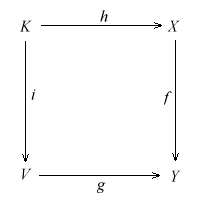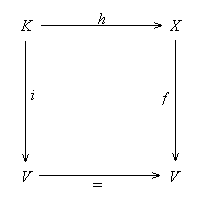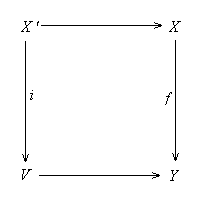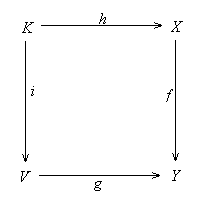|
In this section we assume C is a simple spectral site. A valuation object V of C is an irreducible locality such that any birational morphism of irreducible localities f: X ® V is an isomorphism. We shall denote by T and K the closed point and the generic point of a valuation object V respectively. Let i: K ® V be the effective inclusion. Definition 6.4.1. We say C has enough valuations if for any morphism f: X ® Y, a point x Î |X|, and a specialization y of f(x), there exist a valuation object V and morphisms g: V ® Y, h: K ® X with g(T) = y, h(K) = x, such that the following diagram commutes:  In the following we assume C has enough valuation objects. Consider the following conditions on a morphism f: X ® Y: (V1) For any valuation object V and g, h as above (6.4.1), there exists at most one morphism from V to X making the diagram commutative. (V2) For any valuation object V and g, h as above (6.4.1), there exists a morphism V ® X making the diagram commutative. Remark 6.4.2.
(a) The composition of two morphisms satisfies (V1) or (V2)
if each of them satisfies (V1) or (V2).
Lemma 6.4.3. A morphism f: X ® Y satisfies (V1) if and only if the diagonal morphism Df: X ® X ×Y X satisfies (V2). Proof. Suppose Df:
X ® X
×Y X satisfies (V2). Let g,
h be as in diagram (6.4.1). Suppose j,
j': V ®
X are two morphisms making the diagram commutes. Then the restrictions
j, j' on the generic point K of V are equal.
Consider the canonical morphism (j, j'): V ®
X ×Y X. Since the composition K
® V ®
X ×Y X can be factored through Df:
X ® X
×Y X, applying (V2) we see that
(j, j') can also be factored through Df.
This implies that j = j'.
Lemma 6.4.4. Suppose f: X ® V is a stable morphism and V is a valuation object. Suppose h: K ® X is a V-morphism forming a commutative diagram:  Proof. We may assume |X| is the closure of h(K). Since K ® h(K) ® K is an isomorphism, K ® h(K) is a section, hence an isomorphism because C is simple. Since f is stable, we have |f(X)| = V as any point of V is a specialization of K. Let x Î |X| be a point above T. Then the restriction of f on the locality xo is an isomorphism xo ® V since V is a valuation object. The composition V ® xo ® X is a section of f making the diagram commutative. Theorem 6.4.5. A morphism f: X ® Y is universally stable if and only if the condition (V2) holds for f. Proof. (a) First we assume the condition (V2)
holds for f. To prove that f is universally stable it suffices
to prove that f is stable since the property that a morphism satisfies
(V2) is universal. We verify the condition (6.2.4.b) for f,
which will then imply that f is stable. Let x Î
|X| and y = f(x). Let y' be a specialization
of y. By (6.4.1) there is a valuation object V, a morphism
g: V ®
Y and a morphism h: K ®
Y such that g(T) = y', h(K) =
x, and h: K ®
x is an isomorphism of spots such that the diagram of (6.4.1)
commutes. Applying (V2) we find a morphism j: V
® X making that
diagram commute. Let x' = j(T) be the image of T
Î |V| in |X|.
Then f(x') = y', and x' is a specialization
of x.
 Theorem 6.4.6. (Valuation
Criterion for Separated Morphisms). Suppose f: X ®
Y is a morphism. The following conditions are equivalent:
Proof. (a) and (b) are equivalent by (6.3.3b)
and (5.3.3).
Theorem 6.4.7, (Valuation
Criterion for Universally Closed Morphisms). Suppose f: X ®
Y is a quasi-compact morphism. Then the following conditions are equivalent:
Proof. (a) and (b) are equivalent by (6.1.14.a)
and (6.2.8);
Proposition 6.4.8.
Suppose C is a spectral site with a simple model C'
which is a spectral site having enough valuation objects. Then
 (b) Consider the following conditions on a morphism f: X ® Y in C: (U1) For any valuation object V and g, h as above, there exists at most one morphism from V to X making the diagram commutative. (U2) For any valuation object V and g, h as above, there exists a morphism V ® X making the diagram commutative. Then f is separated if and only if f is quasi-separated and satisfies (U1). If f: X ® Y is a quasi-compact morphism, then f is universally closed if and only if (U2) holds for f. Proof. Denote by J: C ® C' the isometric coreflector. Applying (6.4.1) to J(f): J(X) ® J(Y) we see that (a) holds. (b) follows easily from (6.4.6) and (6.4.7). Example 6.4.9. The site GSch of reduced schemes is a simple spectral site with enough valuation objects: the spectrum Spec(A) of any valuation ring A is a valuation object of GSch. Thus (6.4.6) and (6.4.7) hold for GSch. Example 6.4.10. The site LNGSch of locally noetherian reduced schemes with morphisms of finite type is a simple spectral site having enough valuation objects: the spectrum Spec(A) of any discrete valuation ring A is a valuation object of LNGSch. Thus (6.4.6) and (6.4.7) hold for LNGSch. Example 6.4.11. The
site Sch of schemes is a spectral site with GSch as a simple
model. The site LNSch of locally noetherian schemes with morphisms
of finite type is a spectral site with LNGSch as a simple model.
Hence we can apply (6.4.8) to these two sites.
|